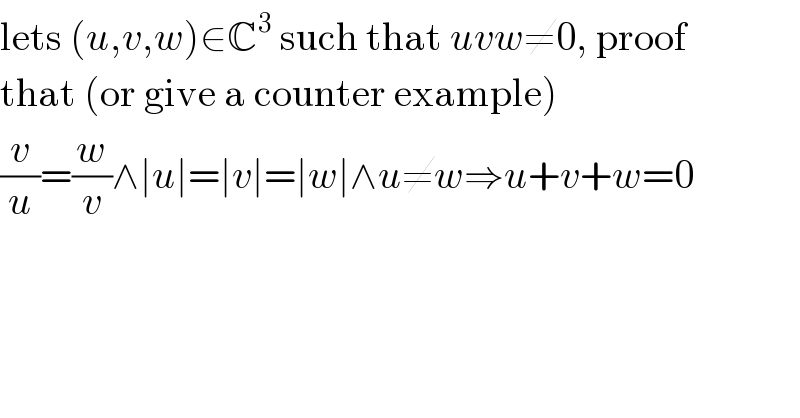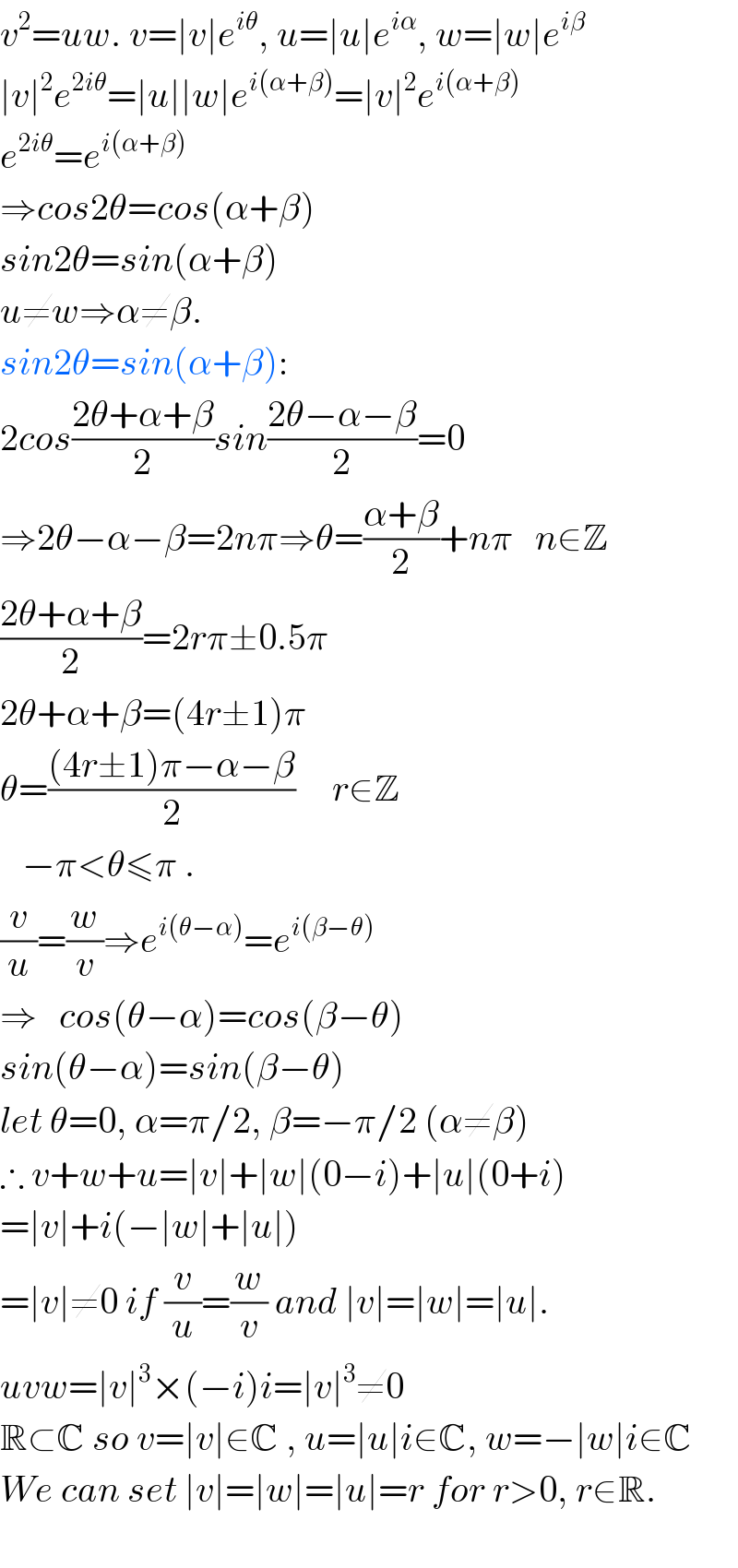Question Number 3410 by 123456 last updated on 13/Dec/15

$$\mathrm{lets}\:\left({u},{v},{w}\right)\in\mathbb{C}^{\mathrm{3}} \:\mathrm{such}\:\mathrm{that}\:{uvw}\neq\mathrm{0},\:\mathrm{proof} \\ $$$$\mathrm{that}\:\left(\mathrm{or}\:\mathrm{give}\:\mathrm{a}\:\mathrm{counter}\:\mathrm{example}\right) \\ $$$$\frac{{v}}{{u}}=\frac{{w}}{{v}}\wedge\mid{u}\mid=\mid{v}\mid=\mid{w}\mid\wedge{u}\neq{w}\Rightarrow{u}+{v}+{w}=\mathrm{0} \\ $$
Commented by RasheedSindhi last updated on 13/Dec/15

$$\mathcal{W}{hat}\:{is}\:{meant}\:{by}\:{u},{v},{w}\in\mathbb{C}^{\mathrm{3}} \:? \\ $$
Commented by 123456 last updated on 13/Dec/15

$${u}\in\mathbb{C}\wedge{v}\in\mathbb{C}\wedge{w}\in\mathbb{C} \\ $$
Commented by RasheedSindhi last updated on 13/Dec/15

$${Do}\:{you}\:{mean} \\ $$$${Given}:\left({u},{v},{w}\right)\in\mathbb{C}^{\mathrm{3}} \:\wedge\:{uvw}\neq\mathrm{0} \\ $$$$\:\:{To}\:{prove}:\frac{{v}}{{u}}=\frac{{w}}{{v}}\wedge\mid{u}\mid=\mid{v}\mid=\mid{w}\mid\wedge{u}\neq{w}\Rightarrow{u}+{v}+{w}=\mathrm{0}? \\ $$$$ \\ $$
Commented by 123456 last updated on 13/Dec/15

$$\mathrm{yes}\:\left(\mathrm{or}\:\mathrm{give}\:\mathrm{a}\:\mathrm{conter}\:\mathrm{example}\right) \\ $$
Commented by Yozzi last updated on 13/Dec/15

$${v}^{\mathrm{2}} ={uw}.\:{v}=\mid{v}\mid{e}^{{i}\theta} ,\:{u}=\mid{u}\mid{e}^{{i}\alpha} ,\:{w}=\mid{w}\mid{e}^{{i}\beta} \\ $$$$\mid{v}\mid^{\mathrm{2}} {e}^{\mathrm{2}{i}\theta} =\mid{u}\mid\mid{w}\mid{e}^{{i}\left(\alpha+\beta\right)} =\mid{v}\mid^{\mathrm{2}} {e}^{{i}\left(\alpha+\beta\right)} \\ $$$${e}^{\mathrm{2}{i}\theta} ={e}^{{i}\left(\alpha+\beta\right)} \\ $$$$\Rightarrow{cos}\mathrm{2}\theta={cos}\left(\alpha+\beta\right) \\ $$$${sin}\mathrm{2}\theta={sin}\left(\alpha+\beta\right) \\ $$$${u}\neq{w}\Rightarrow\alpha\neq\beta.\: \\ $$$${sin}\mathrm{2}\theta={sin}\left(\alpha+\beta\right): \\ $$$$\mathrm{2}{cos}\frac{\mathrm{2}\theta+\alpha+\beta}{\mathrm{2}}{sin}\frac{\mathrm{2}\theta−\alpha−\beta}{\mathrm{2}}=\mathrm{0} \\ $$$$\Rightarrow\mathrm{2}\theta−\alpha−\beta=\mathrm{2}{n}\pi\Rightarrow\theta=\frac{\alpha+\beta}{\mathrm{2}}+{n}\pi\:\:\:{n}\in\mathbb{Z} \\ $$$$\frac{\mathrm{2}\theta+\alpha+\beta}{\mathrm{2}}=\mathrm{2}{r}\pi\pm\mathrm{0}.\mathrm{5}\pi \\ $$$$\mathrm{2}\theta+\alpha+\beta=\left(\mathrm{4}{r}\pm\mathrm{1}\right)\pi \\ $$$$\theta=\frac{\left(\mathrm{4}{r}\pm\mathrm{1}\right)\pi−\alpha−\beta}{\mathrm{2}}\:\:\:\:\:{r}\in\mathbb{Z} \\ $$$$\:\:\:−\pi<\theta\leqslant\pi\:. \\ $$$$\frac{{v}}{{u}}=\frac{{w}}{{v}}\Rightarrow{e}^{{i}\left(\theta−\alpha\right)} ={e}^{{i}\left(\beta−\theta\right)} \\ $$$$\Rightarrow\:\:\:{cos}\left(\theta−\alpha\right)={cos}\left(\beta−\theta\right) \\ $$$${sin}\left(\theta−\alpha\right)={sin}\left(\beta−\theta\right) \\ $$$${let}\:\theta=\mathrm{0},\:\alpha=\pi/\mathrm{2},\:\beta=−\pi/\mathrm{2}\:\left(\alpha\neq\beta\right) \\ $$$$\therefore\:{v}+{w}+{u}=\mid{v}\mid+\mid{w}\mid\left(\mathrm{0}−{i}\right)+\mid{u}\mid\left(\mathrm{0}+{i}\right) \\ $$$$=\mid{v}\mid+{i}\left(−\mid{w}\mid+\mid{u}\mid\right) \\ $$$$=\mid{v}\mid\neq\mathrm{0}\:{if}\:\frac{{v}}{{u}}=\frac{{w}}{{v}}\:{and}\:\mid{v}\mid=\mid{w}\mid=\mid{u}\mid. \\ $$$${uvw}=\mid{v}\mid^{\mathrm{3}} ×\left(−{i}\right){i}=\mid{v}\mid^{\mathrm{3}} \neq\mathrm{0} \\ $$$$\mathbb{R}\subset\mathbb{C}\:{so}\:{v}=\mid{v}\mid\in\mathbb{C}\:,\:{u}=\mid{u}\mid{i}\in\mathbb{C},\:{w}=−\mid{w}\mid{i}\in\mathbb{C} \\ $$$${We}\:{can}\:{set}\:\mid{v}\mid=\mid{w}\mid=\mid{u}\mid={r}\:{for}\:{r}>\mathrm{0},\:{r}\in\mathbb{R}. \\ $$$$ \\ $$
Commented by Yozzii last updated on 13/Dec/15

$${Testing}\:{new}\:{feature} \\ $$
Answered by prakash jain last updated on 13/Dec/15

$$\mathrm{Counter}\:\mathrm{Example}\:\mathrm{from}\:\mathrm{Yozzi}'\mathrm{s}\:\mathrm{comment} \\ $$$${a},−{ai},{ai} \\ $$
